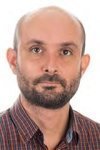Prof. Dr. Chris Poulton
Image: PrivateChris Poulton is Associate Professor in the Department of Mathematical Sciences at the University of Technology Sydney (UTS), where he has been since 2007. He leads the Theoretical Photonics group at UTS, whose research focus is on the theory and modelling of electromagnetic and elastic waves in composite materials, optomechanics, and metamaterials. He also leads the UTS node of CUDOS, the ARC Centre of excellence for Ultra-high bandwidth Devices and Optical Systems. A/Prof. Poulton’s research interests cover photonic crystals and integrated photonics devices, and he has worked on problems of nonlinear optics, plasmonics, optomechanics and photon-phonon interactions, as well as on the development of novel numerical techniques in photonics and phononics.
Dr. Poulton received his PhD from the University of Sydney in 2000 for his work on electromagnetic and elastodynamic wave propagation in periodic materials. In 2000 he was appointed Lecturer in Applied Mathematics at the University of Liverpool, UK, where he worked on analytical models of photonic and phononic crystals and co-authored a book on asymptotic methods in electromagnetism. From 2002-2005 he was a post-doctoral fellow at the Institute for High-frequency and Quantum Electronics at the University of Karlsruhe, Germany, where he worked with experimentalists on developing integrated nonlinear devices. At the start of 2006 he joined the Max Planck Research Group (photonics and new materials) in Erlangen, Germany, where he worked on plasmonic interactions and guidance in photonic crystal fibres. He has been at UTS since July 2007.
Dr. Poulton’s research focus is on the physics and modelling of advanced nanophotonic materials and devices. His area of expertise is in the numerical and analytical modeling of confined states, waveguides, and metamaterials. Central to this work are photonic crystals and photonic crystal fibres; specially designed structures in which photons can be trapped, guided, or otherwise manipulated. An important part of this research involves the electromagnetic properties of metals at optical wavelengths – these problems are interesting from a computational point of view because they are so difficult to model, owing to the large momentum carried by the electron in comparison to the photon. Composites formed of metals and dielectrics also have exceptionally interesting optical properties – in particular, there has recently been much excitement over a new class of materials, combining metals and dielectrics, known as metamaterials. These revolutionary new materials can be used to control the motion of light through space in a manner resembling a strong gravitational field. This leads to a number of interesting possibilities, including the electromagnetic cloaking of objects, as well as the resolution of images beyond the diffraction limit. Dr. Poulton is also interested in the elastodynamic properties of periodic materials, including those possessing phononic band gaps, in which all sturctural vibrations propagating through the material are damped.
personal website of Chris PoultonExternal link
Lecture 1: Good Vibrations: Optomechanics and Stimulated Brillouin Scattering in Modern Nanophotonics
Time: September 15, 2016, 10 am
Place: ACP Auditorium, Albert-Einstein-Str. 6, 07745 Jena
The interaction between light and sound has a long and distinguished history in physics. Recently researchers have begun to harness opto-acoustic interactions in the context of nanophotonics, in which light is trapped or guided within structures that possess features that are typically as large as the wavelength of light (and sound) in the material. Within this field, which can broadly categorized as nano-optomechanics, several important physical processes occur that serve to link electromagnetic and elastodynamic degrees of freedom. One particularly important process in nanophotonic waveguides is Stimulated Brillouin Scattering (SBS), which is a coherent interaction between the guided optical and acoustic modes. SBS can lead to several interesting and unusual effects, including "slow-light", by which the speed of light is reduced to a fraction of its value in vacuum, as well as having a number of important applications in sensing and narrow-linewidth source generation. Here we discuss the physics behind optomechanics and SBS and overview recent progress in harnessing optomechanical interactions in on-chip optical waveguides. In sum, this lecture consists of an overview of optomechanics and SBS in modern nanophotonics, and will cover the fundamental physics as well as reviewing recent progress in harnessing optomechanical interactions in on-chip optical waveguides.
Lecture 2: Brillouin Scattering - Theory and Fundamentals
Time: September 26, 2016, 11:45 am
Place: DokDok 2016 Conference at Schloss Oppurg
Stimulated Brillouin Scattering (SBS) is a coherent nonlinear interaction between the electromagnetic and acoustic waves that occurs in optical waveguides, with a broad range of important on-chip applications. We outline and discuss the current state of the theory of Stimulated Brillouin Scattering (SBS) in the context of integrated optics and structured materials. We discuss recent theoretical results that provide the necessary conditions on material properties, waveguide symmetry, and waveguide dimensions that are required to obtain technologically useful SBS gain, as well as discussing the physical processes that can place limitations on the amount of SBS gain achievable, and introduce figures of merit that may be useful for comparing different SBS platforms.
Lecture 3: Basics of Elasticity for Optical Physicists
Time: October 27, 2016, 3 pm
Place: ACP Auditorium, Albert-Einstein-Str. 6, 07745 Jena
In which the basics of continuum mechanics and elasticity theory will be covered, from the point of view of researchers and students with a background in optics and electromagnetism.
Lecture 4: Basics of Optical Forces and Optomechanics
Time: November 1, 2016, 3 pm
Place: ACP Auditorium, Albert-Einstein-Str. 6, 07745 Jena
In which we cover the fundamentals of optical forces as arising from electromagnetic waves, as well as the inverse effect of mechanically-induced stresses and strains on the propagation of light.
Lecture 5: Basics of Cavity Optomechanics and Stimulated Brillouin Scattering (SBS)
Time: November 8, 2016, 3 pm
Place: ACP Auditorium, Albert-Einstein-Str. 6, 07745 Jena
In which the fundamentals of cavity optomechanics are given, as well as an introduction to the phenomenology and experimental requirements for SBS measurements.
